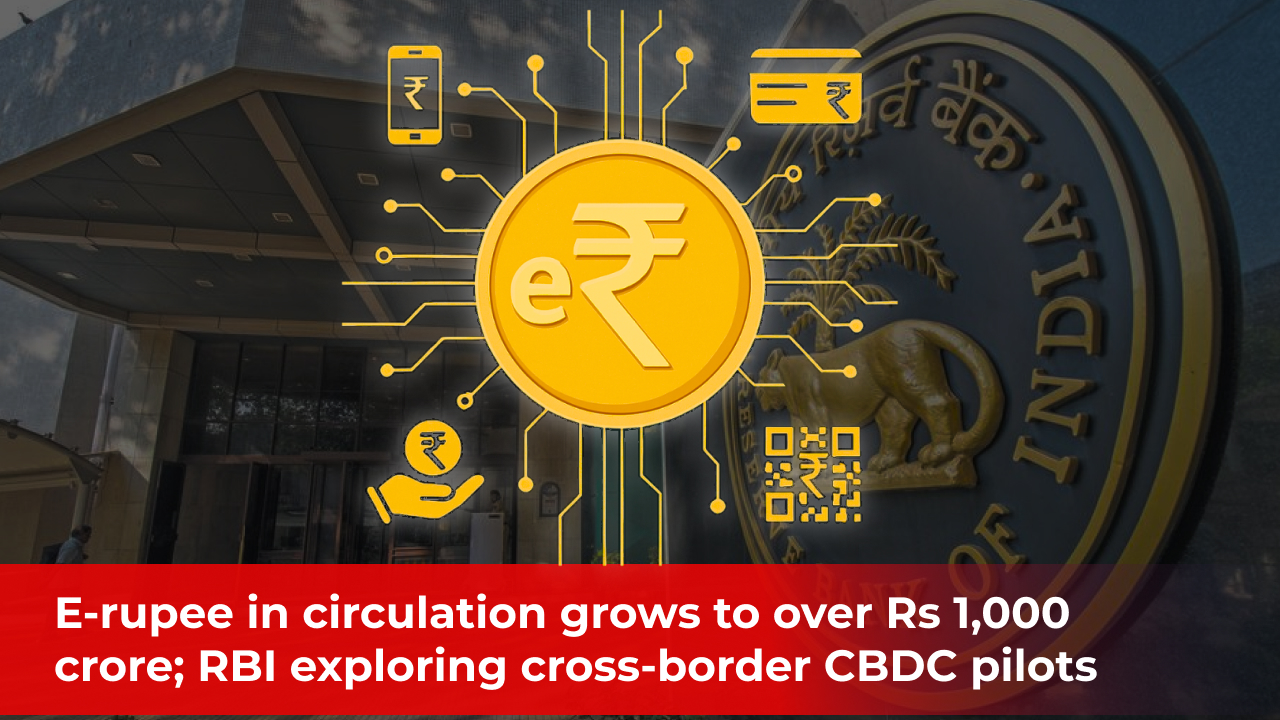The Reserve Bank of India (RBI) released its annual report on Thursday. The report shares the agenda for 2025-26 regarding expanding the scope of India's digital currency, e-rupee, for both retail (e₹-Retail) and wholesale (e₹-Wholesale) segments. The RBI is actively exploring cross-border CBDC pilots to improve payment transparency. The circulation of the e-Rupee had significantly increased to ₹1,016 crore by March 2025.
In November 2022, the CBDC (Central Bank of Digital Currency) was first introduced, and it was initially for wholesale pilots but later supported retail ones. The cross-border payments, which are basically the financial transactions that occur between parties who are located in different countries, need some improvements in their infrastructure and settlement risks, and the CBDC aims to enhance accessibility, financial inclusion, and convenience.

On the afternoon of May 29, the RBI's annual report was released, indicating that the RBI is analyzing cross-border CBDC pilot projects, as PTI reported. For the past few years, there has been potential growth seen in non-flat virtual currencies like Bitcoin, which creates a necessity in the form of challenges, and CBDC possesses such benefits to tackle that.
"...the Reserve Bank is exploring commencement of CBDC pilots on cross-border payments both on a bilateral and multilateral basis to overcome key challenges related to turnaround time, efficiency and transparency," the report stated.
RBI has also participated in the Multilateral and Bilateral CBDC initiatives through the Bank for International Settlements (BIS) Innovation Hub, and central banks also focus more on introducing new features and use cases where planning involves improving technological aspects and account aggregator framework.
"Bilateral cross-border CBDC pilots with select countries are being "actively explored," and progress has been made in finalization of roadmap, technical aspects and use cases," per the annual report. "The Central bank also aims to further expand the scope and coverage of ongoing pilots in e-Rupee-Retail and e-Rupee-Wholesale by introducing new use cases and features and also improve the technological aspects of the account aggregator framework to enhance transparency, customer convenience and efficiency," it states.
The total amount of e-Rupee in circulation is more than ₹1,016, out of which a major chunk is in the ₹500 denominations of e-Rupee. Moreover, highlighting the other denominations which are in ₹200 and ₹100 of e-Rupee, and these are estimated at over ₹91 crore (of ₹200 e-Rupee) and ₹38 crore (of ₹100 e-Rupee). "A bulk of ₹857 crore of the e-Rupee in circulation is in ₹500 denomination," the annual report said.
The annual report also pointed out how the retail pilot of the e-rupee was expanded, with a positive sign encouraging more users to use it. It has been now reached to 17 banks and 60 lakh users. RBI has also planned to enhance distributions, and its adaptability of CBDC wallets, there are a number of non-banks or non banking financial instituations now have been able to offer CBDC wallets so that e-Rupee wholesale scope can be expended and diversified.
"Starting with the initial use cases of person-to-person (P2P) and person-to-merchant (P2M), the Reserve Bank expanded the Central Bank Digital Currency (CBDC)-Retail (e-Rupee-R) pilot to include offline and programmability features in FY25," the annual report said as of the end of March 2025.
Powering this statement, earlier this year, Mobikwik and CRED launched their own CBDC wallet, developed in collaboration with the RBI and YES BANK and made available to all the android users. It comes with peer-to-peer (P2P) and peer-to-merchant (P2M) transactions as features. "To further enhance adoption and improve distribution, certain non-banks have been allowed to offer CBDC wallets. Moreover, the scope of e-Rupee-Wholesale was further expanded and diversified with the addition of four standalone primary dealers (SPDs)," the report states.
In the Odisha state, the government has made e-rupee payments to over 88,000 beneficiaries under a welfare scheme for women to empower women between the age group of 21 and 60 years, where the government provides straight financial aid. There are discussions that are ongoing among different central and state ministries to leverage CBDC features and promote them with a defined end use. Adding to that, the programmability use cases include direct benefit transfers to farmers against the generation of carbon credits and loans to tenant farmers under the Kisan Credit Card (KCC) in select locations. It is also acclaimed for adding that bank employees' allowances for fuel/meal purposes are also being implemented. "Odisha has made e-Rupee payments to 88,000 beneficiaries under the Subhadra Yojana," the annual report said, adding that discussions are underway with multiple Central Government Ministries and State Governments for leveraging the programmability feature of CBDC to transfer funds to beneficiaries with a defined end use.
The Central Bank of Digital Currency has shown a positive response since 2022, opening a broader scope toward the transformation of digital payment transactions on a full scale, and for that, there is a need for infrastructure.
Reference Links:
- https://rbidocs.rbi.org.in/rdocs/AnnualReport/PDFs/0ANNUALREPORT202425DA4AE08189C848C8846718B080F2A0A9.PDF
- https://www.thehindu.com/business/e-rupee-in-circulation-grows-to-1016-crore-rbi-explores-cross-border-cbdc-pilots/article69632789.ece
- https://timesofindia.indiatimes.com/business/india-business/e-rupee-circulation-rises-to-rs-1016-crore-rbi-to-explore-cross-border-cbdc-pilots/articleshow/121493447.cms
